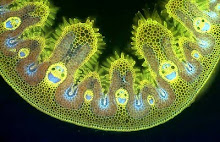English florists' tulips have been grown in England since the 17th. century, when they probably arrived here from Holland, and they have been lovingly cultivated by members of the Wakefield and North of England Tulip Society since 1836, who hold an annual show and exhibit their prize blooms in beer bottles. The flowers are notable for their elegant half-cup shape shape and, rather more remarkably, the fact that they are – strictly speaking - diseased. The vibrant colour patterns of the tepals is caused by a virus infection – tulip breaking potyvirus – that’s transmitted by aphids. Pigment production in tepal cells that are infected is drastically altered, causing the colour patterns that have acquired their own distinct nomenclature. Plain coloured, uninfected flowers are known as ‘breeders’ while bulbs that are infected are said to be ‘broken’. Flowers with pigmented tepal edges are said to be ‘feathered’, those with a strong column of colour in the centre of the tepal are ‘flamed’ and spectacular colour patterns like the one above are known as ‘bizarres’, while ‘bibloemens’ are predominantly white with delicate purple or blackish-purple markings.
The patterning produced by the virus infection is unpredictable, but once a bulb has been 'broken' and has been recognised as having a desirable colour pattern it can be propagated vegetatively from bulblets that are produced every year.
Image Source: http://en.wikipedia.org/wiki/File:Semper_Augustus_Tulip_17th_century.jpg
During the height of Tulip Mania in the 17th. century bulbs of virus-infected tulips like like this Semper Augustus changed hands for the equivalent of ten years wages for a skilled craftsman.
















